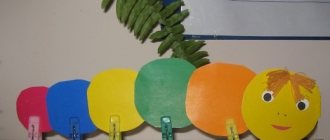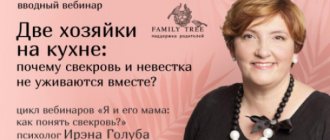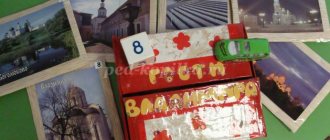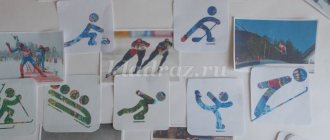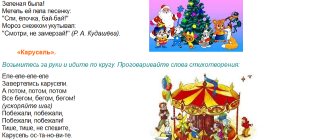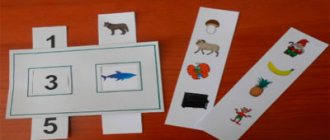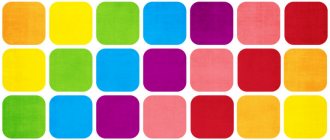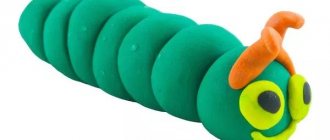"Ladybugs"
Material: cards with the image of ladybugs with a number on the left wing; numbered cards for the second wing; numbers in circles.
Options for using the guide:
1. The teacher places a number in a circle above the ladybugs and invites the children to choose a number for the second wing. The child finds this number and attaches it to the wing.
2. The numbers are located on both wings of the ladybugs. The child needs to make a number from two numbers and find the corresponding number in the circle.
"Amanita"
Material: fly agaric caps are double-sided: white dots are glued on one side (from 1 to 10, on the other - examples; fly agaric paws with numbers from 1 to 10; white and red circles.
Options for using the instructions: 1. “Choose a stem for a hat from a fly agaric”: the task is considered completed correctly if the number of points on the hat matches the number on the stem.
2. “Solve examples”: you need to solve arithmetic examples (on the lid of the fly agaric) and find the answer (the number on the leg of the fly agaric). The task is considered completed successfully if the arithmetic example is solved correctly.
“Equal - unequal” The presenter casually places his feet on the fly agaric caps. Often the numbers on the legs do not correspond to the number of points on the caps. The child must match the number and number of points using double-sided counters. To do this, he covers the extra points on the hat with the red side of the chip and adds the missing points with the white side of the chip. The task is considered correctly completed if the number of points on the hat matches the number on the leg.
"At home"
Material: Houses with windows. There is only one room on each floor. Set of numbers.
How to play: The number on the roof indicates the number of inhabitants on each floor. The child must select and enter a number in the second window.
“Match the wheels to the car” Options for using the guide:
1. The car is given a number. Children must match the wheels to the car so that the number of dice on the two wheels, indicated by the numbers, is the number shown on the car (select all options).
2. Numbered wheels are placed on the car and the child must determine the total number of wheels and put the corresponding number on the car.
"Polyanka"
Material: Polyanka (in green cardboard); 2 types of box colors; Velcro in the center for fixing numbers on the clearing.
How to play: A number is placed in the center of the clearing. The child must make this number from flowers of different colors.
Didactic material for familiarization with the composition of the number of units in the senior group
Nelya Tkachenko
Didactic material on knowing the composition of the number of units in the senior group
Didactic material for knowledge
with a composition of people from the senior group.
SPHERE:
Forming ideas about the composition of the number inside the first bead.
TASKS:
- regulate, -
– ideas about numbers and numbers inside the first bead;
- develop,-
– the idea that all numbers are made of ones;
– the idea that the number of units in different quantities is different;
– attention, visual perception, memory, logical thinking;
– excellent motor skills;
- mention -
– organization;
– concentration;
– interest in mathematical games;
The calculation of the activity of five-year-olds in the process of systematic learning is already objectively perfect. Studying the composition of the number of units in the senior group is preparation for mastering computer technology - counting and counting one at a time.
What else to read: Didactic game “Berry, Vegetable or Fruit?” 5-6 grade
The study of the composition of numbers from units should begin with an analysis of the composition of a set of elements to the composition of a number of units, while one should be consistent, not hasty, and from the heel - from each number - from 2 to 5 (2, 3,4,5)
... For illustrative purposes of the material, a group of objects of the same type is selected, each of which differs from each other in qualitative characteristics (for example, color, size) ... In addition, elements that are united by a concept are used in the future, for example, sets of clothes, dishes, furniture, etc. etc. Along with texture elements, you can use patterns of geometric shapes, strips of paper of different lengths and sizes, etc. It is necessary to teach children, when looking at the sets, to tell how this group is composed, to name each element and their total number.
For example:
“The number 4 consists of the following: 1 green circle, 1 red circle. 1 yellow circle, 1 blue circle – 4 circles in total.”
After counting 4 circles, the child must say how it is composed “that’s four”
emphasizing the number of composition: one - green, one - red, one - yellow, one - blue, four in total. When inviting children to do tasks with different types of groups of objects, you should ask them to say how the group is made up, how many different objects there are and how many there are in total, to name both the objects and their number. Gradually you should move from more specific questions to general ones: “How much did you receive? How much... in total? How do you... (for example, 5 pencils?"
When studying the quantitative composition of a number of units, it is necessary to draw children's attention to the fact that a unit can reflect not only an individual object, but can be a reflection of an entire group of objects. For example, invite children to look at a variety of geometric shapes and answer questions:
– What parts does this set consist of? ("Compiled in three parts"
.
– Name the color and number of parts of this set. (“This set consists of three parts of different colors: one part is red triangles, one is blue triangles, the third is green triangles. There are three parts in total.”
– How many units does the number three consist of? ("Of three separate units"
).
In this task, children must understand that a unit can reflect not only an individual object, but also a group of objects.
In the process of familiarizing children with the composition of a number of units, you can use verbal exercises, -
– forest animals gathered in the clearing: a hare, a hedgehog, a squirrel. How many animals are gathered in the forest clearing? How many different forest animals have gathered in the clearing, etc.
And other tasks, for example -
– take five triangles of different colors;
– draw three different geometric shapes;
– put four different dolls on the table, etc.
Familiarization of children with the composition of a number is carried out in a sequential system of classes, which creates conditions for the formation of new connections that form children's knowledge of quantitative composition, which in turn is preparation for computing activities.
Consultation for teachers and parents “How to explain the composition of numbers to a preschooler”
Simakova Natalya
Consultation for teachers and parents “How to explain the composition of numbers to a preschooler”
you can use
- counting sticks;
- simple household items for counting (apples, candy);
- homemade teaching aids - number houses or cards.
Instructions:
Try to explain to your child the difference between numbers and numbers. A numeral denotes numbers in a letter, and numbers denote the number of objects . For example, if you have fifteen apples, explain that 15 is a number, a quantity, and it is made up of the numbers 1 and 5. Take away ten apples, you are left with five. Explain to your child that the number of apples has become five and this is expressed by the number 5. Five can also be decomposed into other numbers - 1, 2, 3 and so on.
Show your child the composition of numbers using clear examples . Take, for example, three candies. Ask your child to count how many candies you have. Now divide the candies - put two on the table, and hold one in your hands. Ask your child how many there are now. The answer will be the same. Explain that two candies with one and vice versa, one with two, make three. Now place one candy further from the second, and hold the third in your hands. Show your child - here's one candy, here's another, and here's another. This means a three is a unit repeated three times. Record your knowledge on counting sticks.
Manual "Number houses"
Draw number houses on paper with your child. These houses are multi-storey buildings with two apartments on each floor.
Write a number from 2 to 18 in the triangle-roof. Explain that as many residents live on one floor as the owner-number indicates. Use counting sticks, cubes, or other materials to help your child “seat” the residents.
For example, let the number 6 be the master. Choose 6 sticks. Let one person live in one of the apartments on the ground floor - move the stick. Therefore, there are five tenants in the other apartment. So six is five and one.
Thus, when populating the number house, you will get pairs 1 and 5, 2 and 4, 3 and 3, 4 and 2, 5 and 1 - in total there are five floors in the number house. To be more effective, hang posters with such houses in your apartment and ask your child periodically.
Involve your child in solving ordinary household tasks. For example, in a family of three people, offer your child the following type of problem. Place one plate on the table. Ask your child how many more plates need to be placed if there are only three people in the family. He should tell you that you need to put two more plates.
Therefore, one and two plates make three plates. Make cards with compositions of different numbers and review them with your child.
Didactic games in mathematics. Number composition games.
Olga Pavlova
Didactic games in mathematics. Number composition games.
Mathematics is a complex science; in older preschool age, the content of knowledge becomes more complex, and we, teachers, have to think about how to present this or that material to preschoolers. Moreover, to do it in a way that would be not only understandable to them, but also interesting. The leading activity in preschool age is play. That is why all training should take place in a playful way. I have already talked on my blog about didactic games that I use not only in the classroom, but also in individual work. Today I want to talk about some more.
Number composition games.
Goal: Improve knowledge about the composition of the studied numbers. Develop the ability to represent numbers as the sum of two terms (based on clarity).
We begin to study the composition of numbers in the older group. The material is difficult for children, but game techniques help to successfully cope with this task. The composition of a number is two smaller numbers for one number. Here are some options for educational games. I borrowed many ideas from you, dear colleagues.
Option 1: “Clothespins”.
You will need cards with numbers from 1 to 10 and clothespins. If “1” - one clothespin and so on. For example, a card with the number “3”. We attach three clothespins to the card, and now we show that three can consist of 1 and 2 more clothespins (if you attach them opposite to each other). Clothespins can be replaced with paper clips. Both motor skills develop and mathematical knowledge!
Option 2 “Libra”
You can play scales, which have two cups. On one cup we place a weight with the number 5, for example. To balance, you need to put 2 and 3 on the second cup. But scales usually break quickly, and you can’t buy one for every child. Therefore, I use regular scales only at the first stage of getting acquainted with the game, and then we switch to paper ones.
From the photographs it becomes clear how you can complicate the content of this game as you get acquainted with it.
Option 3 “Mathematical flower”
(idea of Ekaterina Smirnova or Lydia Karpenko).
Option 4 “Catch the fish”
(saw at Tatyana Romanevich).
In addition to becoming familiar with the composition of numbers, in older preschool age children become familiar with the basics of geometry. The following game will help them deal with the variety of lines.
Game “Such different lines”
Purpose: To introduce basic geometric concepts: point, line, ray, segment, angle. Learn to distinguish between broken and curved lines, closed and open lines.
Option 1. Children are asked to divide all the pictures into piles. In one pile - open, in the other closed.
Option 2. Settled into a house. Broken lines live in this house, straight lines in this one, and curves in this one.
Option 3. Divide the cards into 5 groups (rays, segments, straight lines, broken lines, curves).
And of course, the development of mathematical concepts is difficult to imagine without the development of logic. For this purpose, I use the well-known games “Tangam”, “Columbus Egg”, “Magic Circle”.
Thanks to these games, and those that I have already described in the section of my blog “Didactic Games,” I manage to interest children in mathematics and make learning fun. Thank you for your attention!

